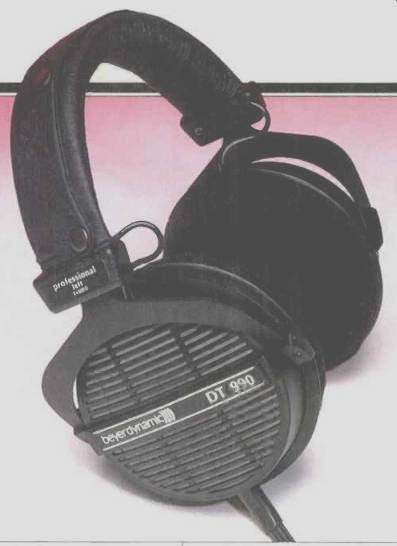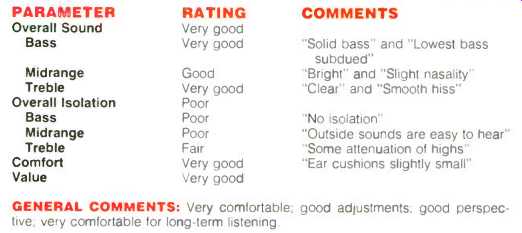
Transducer Design: Dynamic.
Coupling to the Ear: Circumaural, open-air.
D.C. Resistance: Left, 564 ohms; right, 563 ohms.
Absolute Polarity: Positive.
Cord: 9 feet long, coiled; connected from left earcup 1/4-inch stereo phone plug.
Adjustments: Headband slides in detented bail.
Weight: 8 oz.
Price: $274.95.
Company Address: 56 Central Ave., Farmingdale, N.Y. 11735, USA.
My first acquaintance with Beyer was around 1959, when I listened to their DT48 earphones. These 'phones were designed for professional use and were superior to those designed for audiometry at that time. The DT990 Pro has an excellent heritage and does credit to Beyer's long-term commitment to designing and producing high quality earphones.
The DT990 earphones are very light and well made. The plastic bails are made as one continuous plastic molding. The headband, of imitation leather, is attached to a sliding metal piece on the bails. Detents on the bails keep the headband in the selected position; the DT990s are most easily adjusted by removing them, selecting the correct position, and then putting them on again. The left and right earcups can be distinguished by the "L" and "R" embossed on the outside of the sliding bail adjustment. The vinyl ear cushions are covered with a felt-like material I found very comfortable.
==============
EARPHONE EVALUATION PARAMETER

===============

Fig. 1--Output vs. time (bottom) for 20-kHz cosine pulse (top).
The diameter of the ear cushions could be a little larger, at least for my ears, but nevertheless I found them to be relatively comfortable when listening for an hour or more. The felt covering probably makes up for the cushions' slightly small size, because it is better than having vinyl ear cushions used in other earphones, against your skin for any length of time. Another feature of the DT990s that helps in adjusting the earcups to your head is that they are mounted so they can swivel slightly. The tension provided by the plastic bail, which keeps the earcups in place, is not excessive and actually produces a sensation of having very little pressure against the ears. The DT990s weigh only 8 ounces, so it is easy to forget you are wearing them.
The DT990 earphones are "open air" types, which do not have a tight seal at the rear or front of the diaphragm. Because of this, the bass output might be less than in a closed type of earphone, but Beyer has designed the dynamic transducers to account for the lack of a tight seal and the output in the bass range has been increased by using a tuned-port technique. The attenuation of outside sound is negligible, and it is quite easy to hear outside sounds.
The DT990s' subjective sound qualities were rated by members of a listening panel, many of whom have been evaluating high-quality audio components with me for years. They were asked to listen to various types of program material and write down their comments. The measurements I made showed that the bass output was very extended, with only a slight roll-off of about 10 dB at 32 Hz compared to the output at 64 Hz. Comments by members of the listening panel--such as "solid bass," "tight bass," and "lowest notes slightly subdued"--correlate well with my technical measurements in this regard. Comments about the sense of presence as being "excellent" and "bright" correlate well with the measurements I made with the B & K head and torso simulator (HATS) mannequin (which I discussed in the article "As Close As You Can Get" in the April 1991 issue). Beyer has designed the DT990 earphones to have a diffuse-field response that closely matches that of the B & K measuring system. The Stax SR-Lambda Pro earspeakers, which I use as reference, showed a dip at 2.8 kHz when measured with the B & K system's diffuse field response (see my review, also in the April 1991 issue), and the listening panel's members all commented that the DT990s sounded brighter than the reference.
Listening panel comments of "bright" and "extended highs" about the mid- and high-frequency range also correlate well with the way the Beyer DT990 earphones reproduced the spectrum of a 500-Hz square wave; the natural harmonic output at 3.5, 4.5, and 6.5 kHz were accentuated, as were the harmonics at 17.5 and 18.5 kHz. The shape of the 500-Hz square wave was excellent, with a slight tilt showing some low-frequency phase shift.
Figure 1 is the output of the Beyer DT990 earphones for a 20-kHz cosine input. The output after the input has stopped correlates with a listener comment regarding "excellent details," since the output shows a good recovery and very little ringing. It also shows that the DT990 earphones produce a positive acoustical output for a positive electrical input. This caused very favorable comments about the articulation of voices, the sound of brass; and other asymmetrical musical sounds.
I also measured the frequency response with a Fast Fourier Transform (FFT) analyzer by using the same 20 kHz cosine pulse with a B & K 4133 mike directly in front of the earphone element. The response was very flat; a slight dip at 5.5 kHz might have been caused by reflections between the transducer diaphragm and the protective metal screen in front of it. The ear cushions and the other exposed parts of the earcup are well padded, and I don't think that they were the cause of this dip. In any case, the relationship between the amplitude- and phase-transfer functions of the output showed that the response was minimum phase. There was a very slight coloration that I would describe as an "aaw," as in "aaw, that's not bad at all." The rated impedance of the Beyer earphones is 600 ohms, which means that the impedance of the source should have very little effect on the shape of their response. If the DT990s sound different when fed from different sources, you can therefore blame the sources, not the earphones. Even with their high impedance, the high efficiency of these earphones means that the DT990s can produce very high sound levels with relatively little input power.
The Beyer DT990s are very comfortable, and it is easy to forget that you are wearing them even when listening over long periods. The listening panel gave the DT990 a rating of "very good" for overall sound quality and for physical attributes. I personally think that they are very close to the Stax SR Lambda Pro reference earphones, and only a slight veiling of the sound keeps them from being the Lambda Pro's equal. When the prices are compared, I think they are a very good value.
-Edward M. Long
(adapted from Audio magazine, Apr. 1992)
Also see:
Beyerdynamic DT 770 Pro Earphones (Mar. 1993)
Beyerdynamic DT-911 headphones--review, teardown and analysis (Jan. 1993)
Sennheiser HD-540 Reference II headphones (Jun. 1992)
Headroom Supreme Headphone Amp & Image Processor (Jan. 1995)
= = = =